Transit of Venus 2012: Eye Safety
B. Ralph Chou, M.Sc., OD
Associate Professor, School of Optometry, University of Waterloo
Watching the profile of Venus as it passes across the Sun during a transit is a wonderful demonstration of the way the solar system works. Over the course of several hours, Venus traces a path across the disk of the Sun, then leaves, in what can be thought of as an extreme example of an annular eclipse of the Sun.
Observing the Sun, however, can be dangerous if the proper precautions are not taken. The solar radiation that reaches the surface of Earth ranges from ultraviolet (UV) radiation at wavelengths longer than 290 nm, to radio waves in the metre range. The tissues in the eye transmit a substantial part of the radiation between 380–400 nm to the light-sensitive retina at the back of the eye. While environmental exposure to UV radiation is known to contribute to the accelerated aging of the outer layers of the eye and the development of cataracts, the primary concern over improper viewing of the Sun during the transit is the development of “solar retinopathy” or retinal burns.
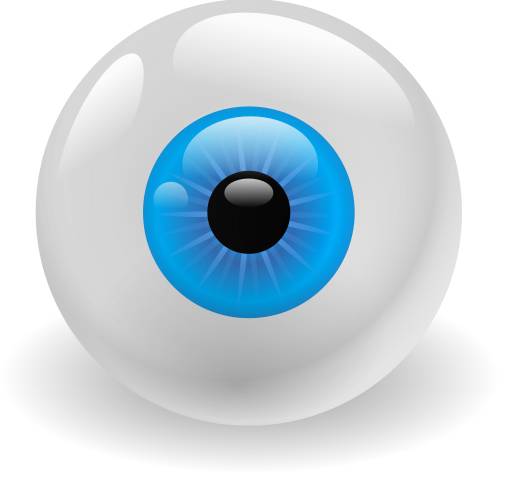 Exposure of the retina to intense visible light causes damage to its light-sensitive rod and cone cells. The light triggers a series of complex chemical reactions within the cells which damages their ability to respond to a visual stimulus, and in extreme cases, can destroy them. The result is a loss of visual function, which may be either temporary or permanent depending on the severity of the damage. When a person looks repeatedly, or for a long time, at the Sun without proper eye protection, this photochemical retinal damage may be accompanied by a thermal injury—the high level of visible and near-infrared radiation causes heating that literally cooks the exposed tissue. This thermal injury or photocoagulation destroys the rods and cones, creating a small blind area. The danger to vision is significant because photic retinal injuries occur without any feeling of pain (the retina has no pain receptors), and the visual effects do not become apparent for at least several hours after the damage is done (Pitts 1993). Viewing the Sun through binoculars, a telescope, or other optical devices without proper protective filters can result in immediate thermal retinal injury because of the high irradiance level in the magnified image.
Exposure of the retina to intense visible light causes damage to its light-sensitive rod and cone cells. The light triggers a series of complex chemical reactions within the cells which damages their ability to respond to a visual stimulus, and in extreme cases, can destroy them. The result is a loss of visual function, which may be either temporary or permanent depending on the severity of the damage. When a person looks repeatedly, or for a long time, at the Sun without proper eye protection, this photochemical retinal damage may be accompanied by a thermal injury—the high level of visible and near-infrared radiation causes heating that literally cooks the exposed tissue. This thermal injury or photocoagulation destroys the rods and cones, creating a small blind area. The danger to vision is significant because photic retinal injuries occur without any feeling of pain (the retina has no pain receptors), and the visual effects do not become apparent for at least several hours after the damage is done (Pitts 1993). Viewing the Sun through binoculars, a telescope, or other optical devices without proper protective filters can result in immediate thermal retinal injury because of the high irradiance level in the magnified image.
Because the apparent diameter of Venus is only 1/30 that of the Sun, there is never a time during the transit when it is safe to look at it without proper eye protection. Failure to use proper observing methods may result in permanent eye damage and severe visual loss. This can have important adverse effects on career choices and earning potential, because it has been shown that most individuals who sustain solar retinopathy eye injuries are children and young adults (Penner and McNair 1966, Chou and Krailo 1981, and Michaelides et al. 2001).
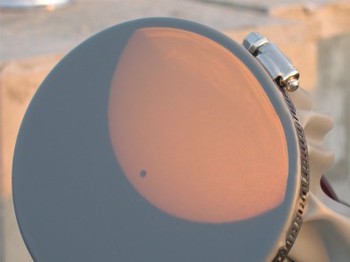 The same techniques for observing the Sun outside of eclipses are used to view and photograph the transit (Sherrod 1981, Pasachoff 2000, Pasachoff and Covington 1993, and Reynolds and Sweetsir 1995). The safest and most inexpensive method is by projection. A pinhole or small opening is used to form an image of the Sun on a screen placed about a metre behind the opening. Binoculars or a small telescope mounted on a tripod can also be used to project a magnified image of the Sun onto a white card. All of these methods can be used to provide a safe view of the transit to a group of observers, but care must be taken to ensure that no one looks through the device. The main advantage of the projection methods is that nobody is looking directly at the Sun. The disadvantage of the pinhole method is that the screen must be placed at least a metre behind the opening to get a solar image with a silhouetted disk of Venus that is large enough to be easily seen.
The same techniques for observing the Sun outside of eclipses are used to view and photograph the transit (Sherrod 1981, Pasachoff 2000, Pasachoff and Covington 1993, and Reynolds and Sweetsir 1995). The safest and most inexpensive method is by projection. A pinhole or small opening is used to form an image of the Sun on a screen placed about a metre behind the opening. Binoculars or a small telescope mounted on a tripod can also be used to project a magnified image of the Sun onto a white card. All of these methods can be used to provide a safe view of the transit to a group of observers, but care must be taken to ensure that no one looks through the device. The main advantage of the projection methods is that nobody is looking directly at the Sun. The disadvantage of the pinhole method is that the screen must be placed at least a metre behind the opening to get a solar image with a silhouetted disk of Venus that is large enough to be easily seen.
The Sun can only be viewed directly when filters specially designed to protect the eyes are used. Most of these filters have a thin layer of chromium alloy or aluminum deposited on their surfaces that attenuates both visible and near-infrared radiation. A safe solar filter should transmit less than 0.003% (density ~4.5) of visible light and no more than 0.5% (density ~2.3) of the near-infrared radiation from 780–1400 nm. (In addition to the term transmittance [in percent], the energy transmission of a filter can also be described by the term density [unitless] where density, d, is the common logarithm of the reciprocal of transmittance, t, or d = log10[1/ t]. A density of '0' corresponds to a transmittance of 100%; a density of '1' corresponds to a transmittance of 10%; a density of '2' corresponds to a transmittance of 1%, etc.). Figure 1 (below) shows transmittance curves for a selection of safe solar filters (Chou 1981, 1998). The "safe" zones of the plot are transmittance levels less than 0.0001 between 200 and 780 nm (above the 1E-04 line in the graph) and transmittance levels less than 0.001 between 780 and 1400 nm (above the 1E-03 line in the graph). The longer infrared between 1400 and 2500 nm does not get past the tears and front of the eyeball, so is not a problem.
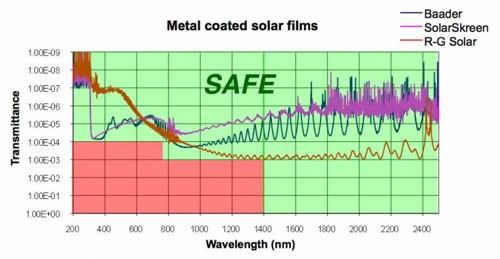
Figure 1: Transmittance curves of selected safe solar filters. This is a logarithmic plot to better show the range of transmittance values across the spectrum from the UV at 200 nm to the infrared (780 to 2500 nm). A transmittance of 1 means no incident energy is blocked. A transmittance of 1E-4 means that 0.01% of incident energy is passing through the filter. Transmittance data for other safe solar filter materials can be found in the NASA Eclipse Technical Publications as well as the articles in Sky and Telescope magazine (Chou 1981 and 1998).
Welder's Glass #14
One of the most widely available filters for safe solar viewing is shade number 14 welder's glass, which can be obtained from welding supply outlets. The transmittance curve of a glass SN14 filter is shown in Figure 2 (below). The shade number is derived from the luminous transmittance of the filter, a property that takes into account how bright human vision would perceive the world through the filter. If SN14 filter is not available, it is possible to combine lower shade numbers to get roughly the same level of eye protection from solar radiation, e.g. combining SN 6 and SN 8 filters. However the image quality may be considerably poorer than that seen through the single SN14 filter.
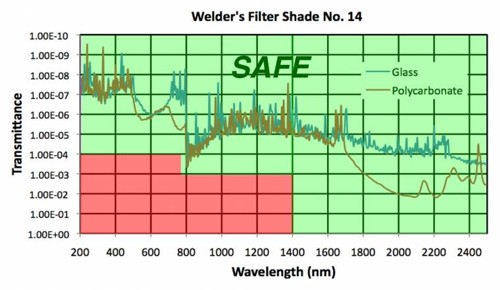
Figure 2: Transmittance curve of glass and polycarbonate SN14 welding filters.
Mylar
A popular inexpensive alternative is aluminized polyester that has been specially made for solar observation. (This material is commonly known as "mylar," although the registered trademark "Mylar®" belongs to Dupont, which does not manufacture this material for use as a solar filter. Note that "space blankets" and aluminized polyester film used in gardening are NOT suitable for this purpose!) Unlike the welding glass, aluminized polyester can be cut to fit any viewing device, and does not break when dropped. It has been pointed out that some aluminized polyester filters may have large (up to approximately 1 mm in size) defects in their aluminum coatings that may be hazardous. A microscopic analysis of examples of such defects shows that despite their appearance, the defects arise from a hole in one of the two aluminized polyester films used in the filter. There is no large opening completely devoid of the protective aluminum coating. While this is a quality control problem, the presence of a defect in the aluminum coating does not necessarily imply that the filter is hazardous. When in doubt, an aluminized polyester solar filter that has coating defects larger than 0.2 mm in size, or more than a single defect in any 5 mm circular zone of the filter, should not be used.
Black Polymer
An alternative to aluminized polyester that has become quite popular is "black polymer" in which carbon particles are suspended in a resin matrix. This material is somewhat stiffer than polyester film and requires a special holding cell if it is to be used at the front of binoculars, telephoto lenses, or telescopes. Intended mainly as a visual filter, the polymer gives a yellow-white image of the Sun (aluminized polyester produces a blue-white image). This type of filter may show significant variations in density of the tint across its extent; some areas may appear much lighter than others. Lighter areas of the filter transmit more infrared radiation than may be desirable. The advent of high resolution digital imaging in astronomy, especially for photographing the Sun, has increased the demand for solar filters of higher optical quality.
Baader Film
Baader AstroSolar Safety Film, a metal-coated resin, can be used for both visual and photographic solar observations. A much thinner material, it has excellent optical quality and much less scattered light than polyester filters. The Baader material comes in two densities: one for visual use and a less dense version optimized for photography.
Thousand Oaks
Thousand Oaks Optical recently introduced a similar filter material, R-G Solar Film, which renders a yellow solar image, unlike aluminized polyester. Filters using optically flat glass substrates are available from several manufacturers, but are more expensive than polyester and polymer filters.
B&W Film
Many experienced solar observers use one or two layers of black-and-white film that has been fully exposed to light and developed to maximum density. Not all black-and-white films contain silver so care must be taken to use a silver-based emulsion. The metallic silver contained in the film acts as a protective filter; however, any black-and-white negative containing images is not suitable for this purpose.
Floppies/CD Disks (Unsafe)
More recently, solar observers have used floppy disks and compact disks (CDs and CD-ROMs) as protective filters by covering the central openings and looking through the disk media. However, the optical quality of the solar image formed by a floppy disk or CD is relatively poor compared to aluminized polyester or welder's glass. Some CDs are made with very thin aluminum coatings that are not safe—if a lighted light bulb can be seen through the CD, it should not be used! No filter should be used with an optical device (e.g., binoculars, telescope, camera) unless it has been specifically designed for that purpose and is mounted at the front end. Some sources of solar filters are listed below.
Unsafe Filters
Unsafe filters include color film, black-and-white film that contains no silver (i.e., chromogenic film), film negatives with images on them, smoked glass, sunglasses (single or multiple pairs), photographic neutral density filters and polarizing filters. See Figure 3 (below). Most of these transmit high levels of invisible infrared radiation, which can cause a thermal retinal burn. The fact that the Sun appears dim, or that no discomfort is felt when looking at the Sun through the filter, is no guarantee that the eyes are safe.
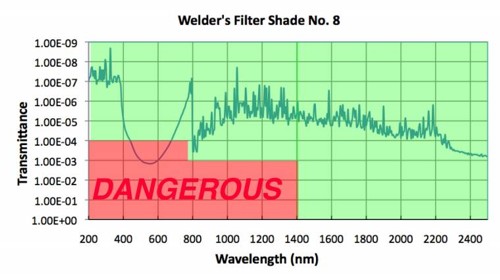
Figure 3: Transmittance curve of unsafe materials sometimes used for viewing the Sun. Shade 8 welder‘s filter (above) is too light in the visible part of the spectrum, and too much infrared radiation is transmitted by the black colour film leader (below).
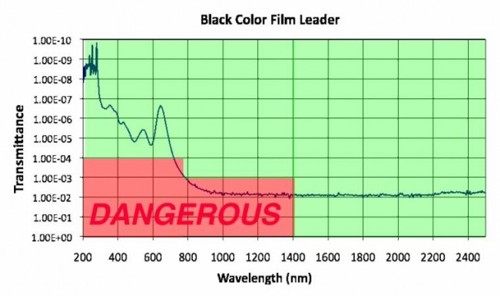
Solar filters designed to thread into eyepieces that are often provided with inexpensive telescopes are also unsafe. These glass filters often crack unexpectedly from overheating when the telescope is pointed at the Sun, and retinal damage can occur faster than the observer can move the eye from the eyepiece. Avoid unnecessary risks. Local planetariums, science centers, or amateur astronomy clubs can provide additional information on how to observe the transit safely.
UVA Radiation
There are some concerns that ultraviolet-A (UVA) radiation (wavelengths from 315–380 nm) in sunlight may also adversely affect the retina (Del Priore 1999). While there is some experimental evidence for this, it only applies to the special case of aphakia, where the natural lens of the eye has been removed because of cataract or injury, and no UV-blocking spectacle, contact or intraocular lens has been fitted. In an intact normal human eye, UVA radiation does not reach the retina because it is absorbed by the crystalline lens. In aphakia, normal environmental exposure to solar UV radiation may indeed cause chronic retinal damage. The solar filter materials discussed in this article, however, attenuate solar UV radiation to a level well below the minimum permissible occupational exposure for UVA (ACGIH 2010), so an aphakic observer is at no additional risk of retinal damage when looking at the Sun through a proper solar filter.
Safety Messages
In the days and weeks before the transit of Venus, there may be news stories and announcements in the media, warning about the dangers of looking at the Sun. Unfortunately, despite the good intentions behind these messages, they frequently contain misinformation, and may be designed to scare people from viewing the transit at all. This tactic may backfire, however, particularly when the messages are intended for students. A student who heeds warnings from teachers and other authorities not to view the transit because of the danger to vision, and later learns that other students did see it safely, may feel cheated out of the experience. Having now learned that the authority figure was wrong on one occasion, how is this student going to react when other health-related advice about drugs, AIDS, or smoking is given (Pasachoff 2001)? Misinformation may be just as bad, if not worse, than no information.
Conclusion
The 2004 transit of Venus was one of the most widely viewed astronomical events in human history. In 2012, most of the Earth except for nations facing the southern Atlantic Ocean will have a view of at least a part of the transit. If skies are clear that day, even more people will witness this event than the last one.
| More information on safe techniques for viewing the sun and the transit of Venus safely are at transitofvenus.org eye safety page. |
Sources for Solar Filters
The following is a brief list of sources for filters that are specifically designed for safe solar viewing with or without a telescope. The list is not meant to be exhaustive, but is a representative sample of sources for solar filters currently available in North America and Europe. For additional sources, see advertisements in Astronomy and or Sky & Telescope magazines. (The inclusion of any source on the following list does not imply an endorsement of that source by the author.)
Sources in the USA:
American Paper Optics, 3080 Bartlett Corporate Drive, Bartlett, TN 38133, (800) 767-8427 or (901) 381-1515
Astro-Physics, Inc., 11250 Forest Hills Rd., Rockford, IL 61115, (815) 282-1513.
Celestron International, 2835 Columbia Street, Torrance, CA 90503, (310) 328-9560.
Coronado Technology Group, 1674 S. Research Loop, Suite 436, Tucson, AZ 85710-6739, (520) 760-1561, (866) SUNWATCH.
DayStar Filters LLC, 149 Northwest OO Highway, Warrensburg, MO 64093, (660) 747-2100.
Meade Instruments Corporation, 16542 Millikan Ave., Irvine, CA 92606, (714) 756-2291.
Rainbow Symphony, Inc., 6860 Canby Ave., #120, Reseda, CA 91335, (818) 708-8400.
Telescope and Binocular Center, P.O. Box 1815, Santa Cruz, CA 95061-1815, (408) 763-7030.
Thousand Oaks Optical, Box 4813, Thousand Oaks, CA 91359, (805) 491-3642.
Sources in Canada:
Khan Scope Centre, 3243 Dufferin Street, Toronto, Ontario, Canada M6A 2T2, (416) 783-4140.
Perceptor Telescopes TransCanada, Brownsville Junction Plaza, Box 38, Schomberg, Ontario, Canada L0G 1T0, (905) 939-2313.
Sources in Europe:
Baader Planetarium GmbH, Zur Sternwarte, 82291 Mammendorf, Germany, 0049 (8145) 8802.
References
American Conference of Governmental Industrial Hygienists Worldwide (ACGIH), 2010: TLVs® and BEIs® Based on the Documentation of the Threshold Limit Values for Chemical Substances and Physical Agents & Biological Exposure Indices, ACGIH, Cincinnati, Ohio, 134-141.
Chou, B.R., 1981: Safe solar filters. Sky & Telescope, 62(2), 119 pp.
Chou, B.R., 1996: Eye safety during solar eclipses—Myths and realities. In: Z. Mouradian and M. Stavinschi, eds., "Theoretical and Observational Problems Related to Solar Eclipses," Proc. NATO Advanced Research Workshop. Kluwer Academic Publishers, Dordrecht, Germany, 243–247.
Chou, B.R., 1998: Solar filter safety. Sky & Telescope, 95(2), 119.
Chou, B.R., and M.D. Krailo, 1981: Eye injuries in Canada following the total solar eclipse of 26 February 1979. Can. J. Optom., 43, 40.
Del Priore, L.V., 1999: "Eye Damage from a Solar Eclipse." In: M. Littmann, K. Willcox, and F. Espenak, Totality, Eclipses of the Sun, Oxford University Press, New York, 140–141.
Michaelides, M., R. Rajendram, J. Marshall, and S. Keightley, 2001: Eclipse retinopathy. Eye, 15, 148–151.
Pasachoff, J.M., 1998: "Public education and solar eclipses." In: L. Gouguenheim, D. McNally, and J.R. Percy, Eds., New Trends in Astronomy Teaching, IAU Colloquium 162, (London), Astronomical Society of the Pacific Conference Series, 202–204.
Pasachoff, J.M., 2000: Field Guide to the Stars and Planets, 4th edition, Houghton Mifflin, Boston, Massachusetts, 578 pp.
Pasachoff, J.M., 2001: "Public Education in Developing Countries on the Occasions of Eclipses." In: A.H. Batten, Ed., Astronomy for Developing Countries, IAU special session at the 24th General Assembly, 101–106.
Pasachoff, J.M., and M. Covington, 1993: Cambridge Guide to Eclipse Photography, Cambridge University Press, Cambridge and New York, 143 pp.
Penner, R., and J.N. McNair, 1966: Eclipse blindness—Report of an epidemic in the military population of Hawaii. Am. J. Ophthal., 61, 1452–1457.
Pitts, D.G., 1993: "Ocular Effects of Radiant Energy." In: D.G. Pitts and R.N. Kleinstein, Eds., Environmental Vision: Interactions of the Eye, Vision and the Environment, Butterworth-Heinemann, Toronto, Canada, 151 pp.
Reynolds, M.D., and R.A. Sweetsir, 1995: Observe Eclipses, Astronomical League, Washington, DC, 92 pp.
Sherrod, P.C., 1981: A Complete Manual of Amateur Astronomy, Prentice-Hall, 319 pp.
| We wish to thank Dr. Ralph Chou for permission to use his article, and Chuck Bueter (transitofvenus.org) for assistance. |
- Log in to post comments
